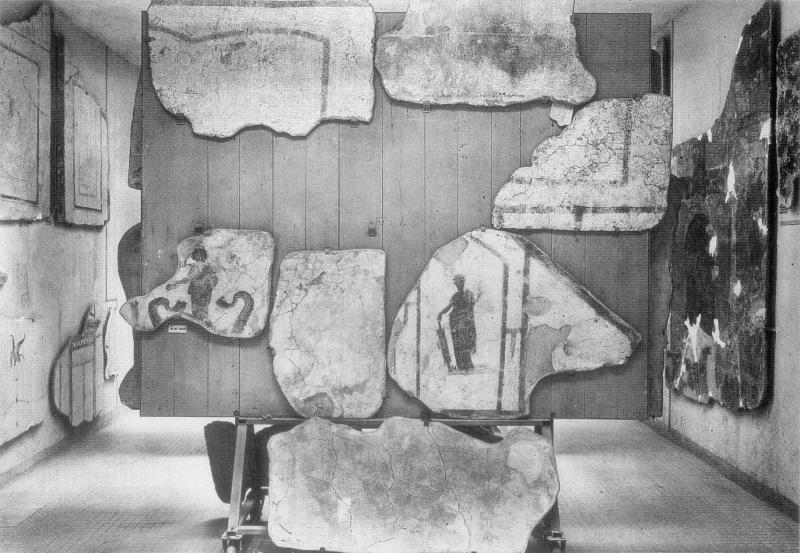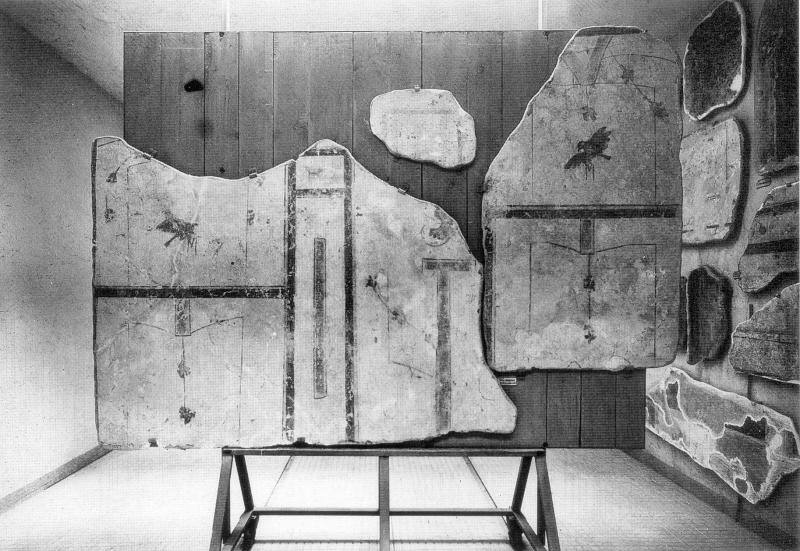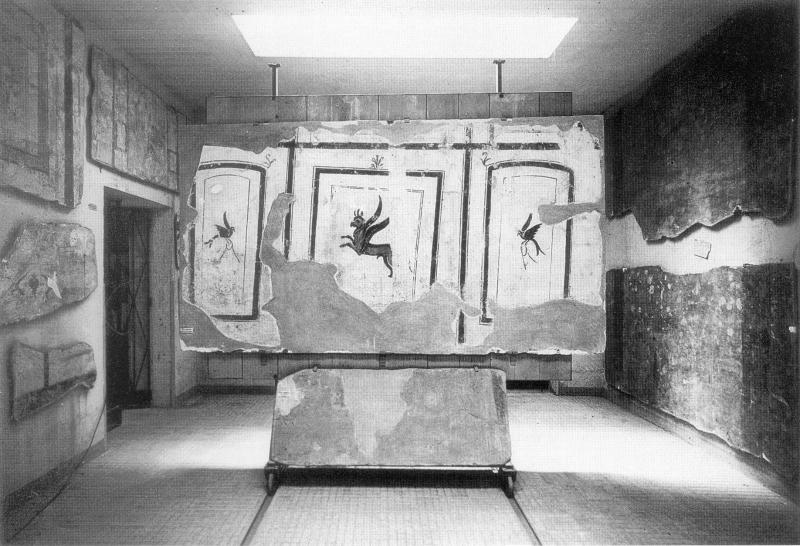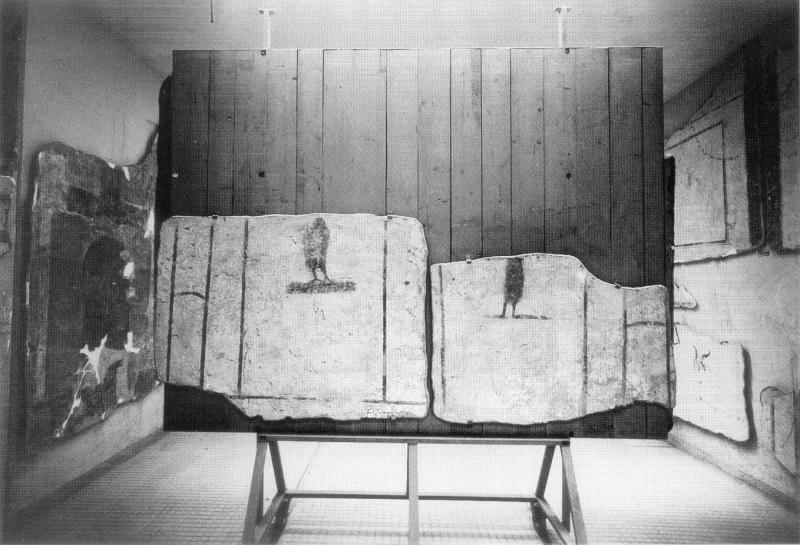We hear about Ostian paintings for the first time in the 19th century. Until 1870 Ostia was property of the Vatican, and excavations were carried out under the supervision of the Vatican. Many finds were taken to the Vatican Museums, including seven paintings from the Porta Laurentina necropolis, from three tombs excavated by Carlo Ludovico Visconti in 1865 (Paschetto 1912, 463 ff., 555):
- Meal in honour of the dead (Marucchi 1922, nr. 969; Museo Lateranense; perhaps from tomb 31).
- Mercurius (Museo Lateranense; perhaps from tomb 31).
- The ship Isis Giminiana (Marucchi 1922, nr. 969; Sala delle Nozze Aldobrandine; perhaps from tomb 31).
- Orpheus and Eurydice in the underworld (Helbig 1963, nr. 1156; Marucchi 1922, nr. 954; Vaglieri 1914, p. 117; Museo Lateranense; from tomb 33).
- Scene from a tragedy (Helbig 1963, nr. 1155; Vaglieri 1914, 117; Marucchi 1922, nr. 956; Museo Lateranense; from the Tomb of the Caecilii, which is perhaps tomb 34).
- The Rape of Proserpina (Helbig 1963, nr. 1155; Vaglieri 1914, 117; Marucchi 1922, nr. 952; Museo Lateranense; from the Tomb of the Caecilii, which is perhaps tomb 34).
- Fruit and a bird (Helbig 1963, nr. 1155; Vaglieri 1914, 117; Museo Lateranense; from the Tomb of the Caecilii, which is perhaps tomb 34).
In an unidentified building ("ben ornata casa"), not far from the necropolis, two fragments were found by Visconti in 1868 (Paschetto 1912, 559; Helbig 1963, nr. 467; Stern 1974, 1975, 1981). These too were taken to the Vatican (Sala delle Nozze Aldobrandine):
- The months August (feast of Diana) and September (Liber Pater, Vendemia).
- The months March (Navigium Isidis) and April (birthday of Septimius Severus).
A painting of Silvanus was found in 1870 by Pietro Ercole Visconti in the Sacello del Silvano (I,III,2). After the excavation it was covered with earth again, to be re-excavated by Guido Calza during the First World War (Paschetto 1912, 559; Bakker 1994, 145).
Other paintings are mentioned without further details: "eleganti pitture" found "in edificio nobilmente arrichito" in 1864, possibly near the Porta Laurentina (Paschetto 1912, 553 nr. 435), and "pitture" that were perhaps found in the Terme di Porta Marina (IV,X,1-2) in 1866 (Paschetto 1912, 557 nr. 460). In the later 19th century a painting of a mythological scene was taken to the Museo Nazionale Romano. It is not known where in Ostia it was found (Borda 1958, fig. 280; Mielsch 2001, Abb. 185).
The museumIn the years 1865-1868 a museum was built in Ostia, by order of pope Pius IX (on the history of the museum of Ostia see Ietto 1996, 14-23 and Angelucci 2006). It was not a new building, but a facade was added to a much older building known as the Casone del Sale. It is still the museum of Ostia. However, in the 19th century it would not be used as museum, but only as office and for storage. In 1870 Ostia became part of the new Italian state. It was now decided that the castle in mediaeval Ostia would be used as Antiquarium, and finds were taken there until 1890. Many objects from Ostia (including the painting with a mythological scene mentioned above) were taken to the Museo Nazionale Romano in Rome, which was inaugurated in 1889. In 1908 Dante Vaglieri became director of the excavations and from now on finds were taken once more to the Antiquarium in the castle.
In the 1920's Guido Calza and Italo Gismondi again took up the idea of using the Casone del Sale as museum. It was modified extensively, only the outer wall of the Casone was preserved. The new museum was inaugurated by Mussolini in November 1934. When the museum was opened it does not seem to have contained many paintings. In his museum guide from 1935 Calza mentions only one, a painting of a bird (Calza 1935, 70). A vast number of paintings emerged during the excavations in the late 1930's and early 1940's. In the early 1960's a special room for the paintings was openend in the museum (Sala XI). Paintings in the storage rooms are stacked on top of each other, and thus basically inaccessible.
Strategies of the excavators for the preservation and conservation
Four strategies of the excavators for the preservation and conservation are encountered in Ostia (see also Liedtke 1995, 21-31):
- Simply leave the paintings on the wall.
- Protect the paintings with a row of roof tiles or another modern "awning".
- Prevent crumbling of the paintings by securing the edges with cement, and sometimes by filling up gaps with plaster or cement.
- Detach the paintings from the wall, fasten them on a panel, and attach the panel to the same wall using metal hooks. The detaching can be done in three ways. Stacco a massello means that all plaster and the wall behind it is removed. This never happened in Ostia. With the strappo-technique only the thin top layer with the paint is removed. This too was not done in Ostia. Instead the "normal" stacco-technique was used. First the painting is covered with cloth that is attached to the painting with a glue. With knives or saws the edge is created of the part that will be detached. Then a modern panel is set against the cloth. The cloth is wider and higher than the panel and the parts that are sticking out are folded back and nailed to the modern panel. Then the painting, cloth and panel are carefully separated from the wall with long iron bars, a procedure during which the wall and painting may be damaged. In the storage rooms most of the ancient plaster behind the paint is removed. The remaining millimeters are then attached to a modern panel, and the cloth is removed.
Once the paintings had been detached they could either be left in situ or taken to the museum or storage rooms. Obviously we would like to know about each painting that is no longer in situ in which building it was found, in which room and on which wall. But in many cases we do not know this, or have only partial information, or are provided with incorrect information. To some extent this is due to the frantic work in the years 1938-1942, when a large part of Ostia was excavated with only meagre documentation. But also after the Second World War paintings could be taken to the storage rooms without recording their location.
Sources for the modern history of the paintingsOf great importance is the photo collection of the "Istituto Centrale per il Catalogo e la Documentazione" (ICCD). Photos of Ostian paintings were taken in 1958 it seems. Many ICCD photographs of detached paintings were taken when the paintings had been moved to an ancient building, which must be the Horrea Epagathiana. C.C. van Essen (1959) repeatedly mentions the "Pinacoteca degli Horrea Epagathiana", and the transferral of a painting from the Domus Fulminata to the Horrea Epagathiana is mentioned by Meiggs (1973, 445 note 2). The ICCD photos have been linked to in the Virtual Museum.
Then there is the photo archive of the Soprintendenza. This is not online and relatively few photos have been published of paintings in situ that were taken to the storage rooms, and of the storage rooms themselves. When it comes to the storage rooms we can distinguish three periods: the use of the Horrea Epagathiana, which was the situation in 1958, documented by the ICCD; walls and panels in later storage rooms, documented on Soprintendenza photographs; the present situation, all the paintings stacked on top of each other.
The Dutch archaeologist C.C. van Essen walked through Ostia in 1949 and described and mentioned many paintings still in situ. His work was published in 1954 in Dutch and in 1959 in Italian. As to more recent publications, especially important for paintings in the museum and storage rooms are Liedtke 1995 and 2003, Mols 1999 (with many references to Soprintendenza and ICCD photographs), and several publications by Falzone. The main museum guides are Helbig 1972, Calza - Floriani Squarciapino 1962 and Floriani Squarciapino 1971. In Helbig the references to ICCD and Soprintendenza photographs (pages 548-552) are very helpful, but not without errors.
The inventory numbers
The museum guides, describing the paintings in Sala XI, mention a few paintings with low inventory numbers:
- 124: Male figure with oxen. From the Terme dei Sette Sapienti, room 3, north wall. Helbig 3172; Guida p. 104 nr. 1; Mols 1999, 299 and fig. 60 = SAOA neg. A1892 (in situ).
- 142: Nilotic scene. From the Porta Laurentina necropis, tomb 22. Found in 1935. Helbig 3184. Guida p. 109 nr. 14. Heinzelmann 2000, Abb. 134 (in situ).
- 155: Male figure sacrificing to Hercules. From the Porta Laurentina necropolis, tomb 27. Found in 1937. Helbig 3182; Guida p. 108 nr. 11.
- 156: Silvanus. Found in the Sacello del Silvano during the First World War (see above). Helbig 3186; Guida p. 110 nr. 16.
- 196: Hypnos. From the Porta Laurentina necropolis, tomb 9. Helbig 3185; Guida p. 109 nr.15.
Shortly after the Second World War a new numbering system was introduced. The lowest inventory number of this series that I am aware of is 10001, a painting with architectural motifs from Horrea I,XX,1. The paintings with inventory numbers higher than 10000 were taken to the museum and store rooms either from newly excavated buildings, or from buildings that had been excavated earlier.
Below is a list of the known inventory numbers in this high range. Note that there are many gaps in the list.
When photos were taken by the ICCD in the Horrea Epagathiana, many paintings were accompanied by a small sign with the inventory number and place of discovery. In the Horrea the paintings were at least partly grouped together according to the place of discovery. So, for example, we see on ICCD neg. nr. E040768 three fragments of garden paintings from the Domus del Ninfeo grouped together (inv. 10085-10087). All fragments on E040876 and E040828 (inv. 10013-10017) come from the Caseggiato degli Aurighi, just like the two fragments on E040867 (inv. 10074 and 10075). On E040754 we see four fragments of paintings with judicial scenes from the Caseggiato dell'Ercole (inv. 10098-10101).
The meta information provided by the ICCD itself is meagre. We have been able to make corrections and additions.
At the time when Sala XI was opened in the museum, the paintings not on display were moved from the Horrea to new storage rooms near the museum. Again they were grouped together according to the place of discovery. Photos of this new arrangement of the storage rooms were published by Liedtke (2003): Taf. 23,45 (Sopr. Ostia B1431); Taf. 24,47 (Sopr. Ostia B1434); Taf. 26,50 (Sopr. Ostia B1425); Taf. 31,60 (Sopr. Ostia B1424); Taf. 31,61 (Sopr. Ostia B1435). The photos may have been taken in the early 1960's, when Sala XI in the museum was opened. Paintings are attached on the side walls, and on wooden panels resting on a metal frame in the centre of the rooms. The frame could be moved back and forth through the room by wheels on rails.
Liedtke 2003 - Taf. 23,45
On Liedtke's plate 23,45 can be seen that on a side wall irregular areas were demarcated by wooden bars. There can be little doubt that each area contains paintings from a single building. In the lower left area is only one painting. This is a painting of fishes from the Terme dei Sette Sapienti. The findspot of several paintings in the other two areas is known, and we may conclude that in the upper left area are seven fragments from the Caseggiato degli Aurighi, in the right area eight fragments from Caseggiato IV,II,5.

Liedkte 2003, Taf. 23,45.
Lower left part: inv. 10040.
Upper left part: inv. 10013, 10015, 10017, 10074, 10075.
Right part: inv. 10066, 10065, 10072, 10071, 10072.
Liedtke 2003 - Taf. 24,47
On 24,47 we see a wooden panel in the centre of the same room (Taf. 31,61 is the other side of this panel, see below). To the left we see the paintings from Caseggiato IV,II,5 mentioned above. To the right of the wooden panel we see a large fragment with a curved upper part that comes from room 22 in the Caseggiato dell'Ercole, where traces of the removal can still be seen. To the right of that we see the left part of a smaller fragment, apparently the lower fragment on E040825 (inv. 10002). On the sign on this ICCD photo we can read that it comes from the same building. The wooden panel in the centre is important for the findspots in block IV,II, if we may assume that paintings on this panel come from the same building. In the topic "The area around the Porta Laurentina" I argue that some of these paintings were found in the Caseggiato dell'Ercole, with the exception of the fragment top right, which is from block V,II, and the two fragments bottom left. A special note is hanging below these paintings.

Liedkte 2003, Taf. 24,47.
Wooden panel: inv. 10100, 10039, 10098 (lower part), 10106, 10084, 10097, and 10102.
Right wall: inv. 10006 and 10002.
Liedtke 2003 - Taf. 26,50
The next photo is 26,50. We see a wooden panel with two large fragments from Edificio IV,II,14 (no photo is available of the other side of the panel). To the right of the panel seven fragments can be seen, mostly without ICCD photos.

Liedkte 2003, Taf. 26,50.
Wooden panel: inv. 10078 and 10079.
Right wall: E040878 (Schola del Traiano).
Liedtke 2003 - Taf. 31,60
Next comes 31,60. On a wooden panel we see a painting of a griffin and two birds that was found in the Caseggiato degli Aurighi. Below it is a painting that may, because of this display, come from the same building. On the right wall are two huge fragments from the Case a Giardino. On the left wall we see four fragments from the Terme della Basilica Cristiana.

Liedkte 2003, Taf. 31,60.
Wooden panel: inv. 10088 and E040815.
Right wall: E040831 and E40871.
Left wall: inv. 10080, 10081, 10082 and E040870.
Liedtke 2003 - Taf. 31,61
The last photo is 31,61. On a wooden panel we see two paintings of male figures found near the Caupona del Pavone. The paintings on the walls to the left and right have been described above (from room 22 in the Caseggiato dell'Ercole and from Caseggiato IV,II,5).

Liedkte 2003, Taf. 31,61.
Wooden panel: inv. 10089.